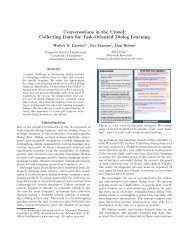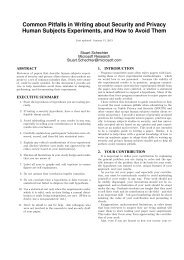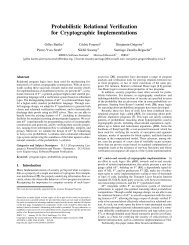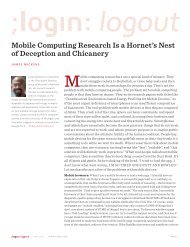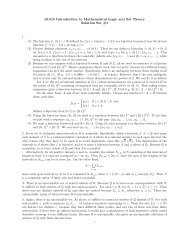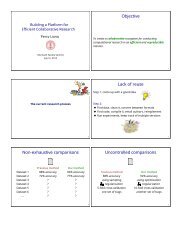PDF file - Microsoft Research
PDF file - Microsoft Research
PDF file - Microsoft Research
Create successful ePaper yourself
Turn your PDF publications into a flip-book with our unique Google optimized e-Paper software.
AUTOMATICALLY IDENTIFYING VOCAL EXPRESSIONS FOR MUSIC<br />
TRANSCRIPTION<br />
Sai Sumanth Miryala<br />
<strong>Microsoft</strong> <strong>Research</strong> India<br />
mssumanth99@gmail.com<br />
Kalika Bali<br />
<strong>Microsoft</strong> <strong>Research</strong> India<br />
kalikab@microsoft.com<br />
Ranjita Bhagwan<br />
<strong>Microsoft</strong> <strong>Research</strong> India<br />
bhagwan@microsoft.com<br />
Monojit Choudhury<br />
<strong>Microsoft</strong> <strong>Research</strong> India<br />
monojitc@microsoft.com<br />
ABSTRACT<br />
Music transcription has many uses ranging from music information<br />
retrieval to better education tools. An important<br />
component of automated transcription is the identification<br />
and labeling of different kinds of vocal expressions such<br />
as vibrato, glides, and riffs. In Indian Classical Music such<br />
expressions are particularly important since a raga is often<br />
established and identified by the correct use of these expressions.<br />
It is not only important to classify what the expression<br />
is, but also when it starts and ends in a vocal rendition.<br />
Some examples of such expressions that are key to<br />
Indian music are Meend (vocal glides) and Andolan (very<br />
slow vibrato).<br />
In this paper, we present an algorithm for the automatic<br />
transcription and expression identification of vocal renditions<br />
with specific application to North Indian Classical<br />
Music. Using expert human annotation as the ground truth,<br />
we evaluate this algorithm and compare it with two machinelearning<br />
approaches. Our results show that we correctly<br />
identify the expressions and transcribe vocal music with<br />
85% accuracy. As a part of this effort, we have created a<br />
corpus of 35 voice recordings, of which 12 recordings are<br />
annotated by experts. The corpus is available for download<br />
1 .<br />
Figure 1. The glide from the third to the fifth note for raga<br />
Bhupali is quick, but in Shuddha Kalyan, it is slower and<br />
perceivably touches the fourth’s microtones.<br />
Figure 2. The third note is steady in raga Bhairavi, but<br />
oscillates across the note’s microtones in raga Darbari<br />
1. INTRODUCTION<br />
Vocal expressions, such as glides, licks, and vibrato are an<br />
intrinsic part of vocal music of any genre. The use of suitable<br />
vocal expressions establishes the characteristic mood<br />
of a song and enhances its emotional appeal. In western<br />
classical music, the appropriate use of vibrato and tremolo<br />
while singing can drastically change the appeal of a given<br />
piece.<br />
Similarly, in North Indian Classical Music (NICM), not<br />
only do vocal expressions enhance or characterize a song’s<br />
mood, they also establish the correctness of a raga’s 2 ren-<br />
1 www.google.com<br />
2 A raga is based on an ascending and descending scale, but is characterized<br />
using many other features and evades a formal definition. See [?]<br />
for a detailed exposition.<br />
Permission to make digital or hard copies of all or part of this work for<br />
personal or classroom use is granted without fee provided that copies are<br />
not made or distributed for profit or commercial advantage and that copies<br />
bear this notice and the full citation on the first page.<br />
c○ 2013 International Society for Music Information Retrieval.<br />
dition. For instance, the nature of the glide between two<br />
notes is a key difference between two ragas, Bhupali and<br />
Shuddha Kalyan, that are based on the same melodic scale<br />
(see Figure ??). Whether the glide from the third to the<br />
fifth note is quick or slow differentiates them (see Table ??<br />
for note definitions). Also, whether a note is steady or oscillating<br />
can also depend on the raga (see Figure 2).<br />
Hence, automatically identifying and labeling such vocal<br />
expressions is very important for accurate music transcription.<br />
In addition, identifying vocal expressions is a<br />
basic requirement towards building tools for music education.<br />
Such an educational tool can process a student’s rendition,<br />
identify the vocal expression and provide feedback,<br />
visual or auditory, on the correctness.<br />
In this paper, we propose an algorithm for automatically<br />
identifying vocal expressions and can therefore be a<br />
building-block for various music transcription and education<br />
tools. The proposed algorithm (a) estimates the pitch<br />
curve, (b) identifies the singing voice frames, (c) processes<br />
the pitch envelope to obtain a canonical representation and
(d) uses templates to identify each expression and finally<br />
create a transcription of the audio signal.<br />
We concentrate on two main expressions predominantly<br />
used in NICM: Meend or a slow glide between notes, and<br />
Andolan or slow microtonal oscillations within the same<br />
note. We limit our discussion in this paper to these because<br />
they are two of the most important vocal expressions that<br />
determine the correctness of a raga. While we do not claim<br />
that our specific algorithm can capture every kind of vocal<br />
expression across all genres, we believe that the overall approach<br />
we have proposed can be used to identify different<br />
styles of vocal expressions across different genres.<br />
The ground-truth is created by manual annotation of the<br />
recordings by experts. We compare the results of our work<br />
with two different machine learning techniques: decision<br />
trees and conditional random fields. Our findings show<br />
that we can achieve up to 85% accuracy across all vocal<br />
expressions identified, an improvement of 7% over a machine<br />
learning-based competitive baseline.<br />
2. RELATED WORK<br />
The automatic transcription of polyphonic music needs to<br />
deal with source separation and note detection in the primary<br />
source. Rao et al. [?] proposed a system for extracting<br />
vocal melody from a polyphonic music signal in NICM<br />
using a spectral harmonic-matching pitch detection algorithm.<br />
The voice signal extracted using these methods can<br />
then be input to our algorithm for identifying expressions.<br />
However this method does not apply to identifying fine vocal<br />
expressions.<br />
Typically, audio alignment for note detection, specifically<br />
onset, steady period and offset of a note, employ<br />
signal processing methods like Dynamic Time Warping<br />
(DTW) in conjunction with graphical models like Hidden<br />
Markov Models (HMM). Devaney et al. [?] used an HMM<br />
model with acoustic features like power and aperiodicity<br />
along with DTW priors to align as well as identify the<br />
transient as well as steady portions of a note. Our technique<br />
does not use onset detection for reasons outlined in<br />
Section ??.<br />
Classification of ragas based on the concept of Pitch<br />
Class Distribution Dyads (PCDD) [?] uses spectrum based<br />
pitch extraction and onset-detection to create Pitch Class<br />
Distribution (PCD) and PCDD. A classifier is then used on<br />
the PCD and PCDDs to identify raga labels. Ross et al. [?]<br />
detects melodic motifs to identify repetition of phrases in<br />
a raga rendition. While all these methods are successful<br />
to a certain extent, they do not take into account the vocal<br />
expressions that may be specific to the composition or introduced<br />
by the singer for a more rich rendition, or in the<br />
music education scenarios, mistakes by a learner.<br />
The biggest challenge for an automatic transcription of<br />
NICM is the absence of a written score that makes any topdown<br />
processing using the score as a knowledge source<br />
practically impossible. A number of approaches for the<br />
transcription of Western music [?] have made use of the<br />
availability of a score as one of the knowledge sources in<br />
their models. Klapuri [?], has an extensive discussion on<br />
Sa Re Ga Ma Pa Dha Ni<br />
Do Re Mi Fa So La Ti<br />
1 st 2 nd 3 rd 4 rd 5 rd 6 rd 7 rd<br />
Table 1. Relative note names in Indian (top) and Western<br />
(bottom) traditions .<br />
Figure 3. Pitch Envelope of a meend from Sa to Dha in<br />
raga Darbari, Sa is 220Hz.<br />
the use of a “musicological model” as a part of a transcription<br />
system. While the system developed in [?] primarily<br />
uses the sinusoidal properties of the polyphonic music signal,<br />
the concluding discussion clearly points to the use of<br />
an existing score for improvement. In a later version of<br />
the polyphonic music transcription [?], they make use of<br />
a reference database for note event modeling, as well as<br />
a musicological model for the transcription system. The<br />
work reported in this paper makes no assumptions about<br />
the availability of a musical score or a knowledge model<br />
and aims to identify and label the different vocal expressions<br />
from the signal using signal processing and machine<br />
learning techniques.<br />
3. BACKGROUND AND DEFINITIONS<br />
NICM follows a relative note system, where all the notes<br />
are sung with respect to the tonic which is called Sa (same<br />
as the Do). The frequency of the tonic depends on the<br />
singer. Table ?? shows the Indian names for the seven<br />
notes corresponding to the western Do-Re-Mi. In this paper,<br />
we focus on the Alap, which is a meterless form of<br />
singing that typically starts any NICM rendition. The alap<br />
captures the essence of the raga being rendered. Alap is<br />
usually sung with no accompaniment except for a background<br />
drone called the Tanpura, which provides the singer<br />
a reference to the tonic.<br />
3.1 Vocal Expressions<br />
As mentioned earlier, the NICM genre uses various characteristic<br />
vocal expressions for enhancing as well as establishing<br />
a raga rendition In our work, we concentrate specifically<br />
on the meend and the andolan.<br />
Meend is a smooth glide from one note to another, as<br />
shown in Figure ??, where the singer moves from Sa to<br />
Dha. This is clearly distinct from a steady note, as shown<br />
in Figure ?? (top). A very short glide is often termed as a<br />
sparsh. For the purpose of this work, we will use the term<br />
glide to refer to both of these.
Figure 5. Annotation of an audio recording, using a mock<br />
pitch envelope.<br />
Figure 4. Pitch Envelope of a steady Re (top) and andolan<br />
around komal Dha (bottom) in raga Darbari.<br />
Andolan is a gentle swing that oscillates between the<br />
lower and the higher microtones of a certain note. Fig. ??<br />
(bottom) shows the pitch curve of an andolan sung around<br />
komal Dha or the minor sixth.<br />
3.2 Problem Definition<br />
Given an audio recording of vocal music in NICM, we<br />
want to label it with a set of annotations that clearly mark<br />
the steady notes as well as the vocal expressions, viz. meend,<br />
sparsh and andolan. In the example in Figure ??. From 0<br />
to 0.6s, a steady Sa (or the first note) is sung, followed<br />
by a meend to the Re or the major second, until time 1.2s.<br />
This is followed by a steady rendition of Re until time 1.6s.<br />
After a meend to komal Ga or the minor third, the singer<br />
sings an andolan around komal Ga. This extends from 2.2s<br />
to 3.9s. Given a vocal rendition in NICM, our objective is<br />
to output the time-series of such annotations.<br />
3.3 Challenges<br />
The task of identifying these vocal expressions and transcribing<br />
NICM faces two primary challenges. First, there<br />
is no written score available. Indian classical music is an<br />
improvisational art-form, and textual representation of musical<br />
pieces, if they exist are very rough and used only as a<br />
tentative guide. There are no equivalent notations for vocal<br />
expressions like trills, vibrato, or tremolo, that exist quite<br />
extensively in western classical music.<br />
Second, in Indian classical music notes generally do not<br />
correspond to clear onsets. Hence, conventional transcription<br />
methods that rely on onset detection cannot be used.<br />
Onset detection algorithms depend on detecting transient<br />
regions in the signal, including sudden bursts in energy or<br />
changes in the spectrum of the signal etc. These methods<br />
fail whenever there is a smooth glide between two notes. In<br />
this work, we present a transcription scheme, which relies<br />
solely on the pitch envelope.<br />
4. TRANSCRIPTION AND EXPRESSION<br />
IDENTIFICATION<br />
The first step towards transcription is the estimation of fundamental<br />
frequency. We chose a difference function based<br />
method for this purpose. This method was preferred over<br />
the frequency-domain methods, because real-time performances<br />
are important for music education tools. No significant<br />
improvement was observed by using the spectral<br />
methods. Any accurate pitch detection method maybe used<br />
for this step.<br />
The second step is to detect audio segments with vocal<br />
singing as against segments with only the background<br />
drone. From the background drone, we detect the tonic,<br />
or the absolute frequency of the base-note for the singer.<br />
The third step is to obtain a canonical representation of the<br />
pitch curve, for which we use a line fitting algorithm to the<br />
curve. The final step is to perform vocal expression identification<br />
using template representations for each expression.<br />
These steps are explained in the following sections.<br />
4.1 Pitch Estimation<br />
In this work the terms pitch and fundamental frequency<br />
are used interchangeably. For each frame, the difference<br />
function is evaluated by subtracting the original signal with<br />
delayed versions of itself. The fundamental frequency corresponds<br />
to the absolute minimum of the difference function.<br />
The other local minima correspond to the harmonics.<br />
We fixed the frame size as 50 ms with 50% overlap for this<br />
work. A low-pass filter with a cutoff frequency of 700Hz is<br />
applied before pitch estimation to remove high frequency<br />
content. Variance of the pitch track is chosen as a measure<br />
to eliminate octave errors using the Viterbi algorithm.<br />
In this work, source separation or multi-band pitch estimation<br />
is not necessary as the singing voice masks the tanpura<br />
sound well.<br />
4.2 Drone and Tonic Detection<br />
The background drone or the tanpura is a stringed instrument<br />
that provides a continuous pitch reference to a vocal<br />
performer. The drone usually consists of four strings,<br />
three of them at the tonic of the scale, and one string tuned<br />
to the fifth note. To identify the singing voice frames in<br />
the recording, we use resonance properties of the drone.<br />
Due to the special form of the bridge fixed to a resonant<br />
body, tanpura shows remarkably different acoustic properties<br />
compared to other stringed instruments [?]. The wide
Figure 6. Pitch envelope & Lines fit using the proposed<br />
method. Critical points are marked with ‘X’<br />
body of the bridge induces a large number of overtones that<br />
manifest in the output of the pitch estimation algorithm. In<br />
frames that contain voice, these overtones are masked by<br />
the voice.<br />
Consequently, the frames with only the drone have higher<br />
entropy than the frames that contain voice. We therefore<br />
use an entropy based method [?] to differentiate the singing<br />
voice frames from the drone. For each audio recording, we<br />
dynamically estimate an entropy threshold from the histogram<br />
of entropy values. Any frame with lower entropy<br />
than the threshold is labeled as a singing voice frame, while<br />
the frames with higher entropy are labeled as the tanpura<br />
frames. Tonic is calculated as the mode of the pitch values<br />
in the frames where tanpura is prominently audible.<br />
4.3 Line Fitting<br />
The third step in the process, is to obtain a canonical representation<br />
of the pitch-curve in terms of straight lines and<br />
critical points of inflection. We use an augmented version<br />
of a previously proposed line-fitting algorithm [?] for this<br />
purpose. We outline our algorithm as follows:<br />
Step 1: Identify the local minima and maxima in the pitch<br />
curve. This gives us a set of points representing the curve.<br />
To achieve better fit along transient regions, the set of points<br />
where the singer is changing notes are added to the list.<br />
These points are identified by scaling down the pitch values<br />
to one octave and mapping the frequencies to notes.<br />
Start a sweep from the left of the curve.<br />
Step 2: Start from the first point on the curve, and connect<br />
it to the third point using a straight line. From this line, if<br />
the second point lies within the distance specified by Just<br />
Noticeable Difference (JND) threshold (equation ??), the<br />
second point is removed. Then, connect the first point to<br />
the fourth point and repeat the JND threshold-based check<br />
for the third point. Repeat this process until you find a<br />
point that lies outside the JND threshold. This point is the<br />
starting point for the next iteration.<br />
Step 3: Starting from the new critical point, repeat Step<br />
2 to find the next critical point. Continue this process until<br />
the whole pitch curve is represented by a set of critical<br />
points and fit lines between these points, by minimizing<br />
the squared error between the pitch curve and the lines fit.<br />
JND1(F ) = 3.13 − 0.13 ∗ F<br />
100<br />
Figure ?? shows a sample pitch envelope and the final<br />
critical points identified. For each pitch curve, we calcu-<br />
(1)<br />
Figure 7. Pitch envelope of the andolan note & Lines fit<br />
using threshold JND1 (top) & JND1/2 (bottom).<br />
late canonical representations by varying the value of the<br />
JND threshold. Small variations in pitch due to singing imperfections<br />
are eliminated in the canonical representation.<br />
These representations are useful in the identification of vocal<br />
expressions of certain types, as we shall describe in the<br />
next subsection.<br />
4.4 Identifying Vocal Expressions<br />
Given the canonical representation of the pitch curve, we<br />
use templates for each kind of vocal expression to recognize<br />
and classify them. A template for each expression is a<br />
loose representation based on some subset of duration, line<br />
lengths, slopes, and number of points. In the next subsections,<br />
we describe templates for andolan and meend, and<br />
how we detect these expressions.<br />
4.4.1 Andolan<br />
Using the expert manual annotations and by studying the<br />
pitch curves ourselves, we have found that an andolan has<br />
the following template: six to ten straight lines, with consecutive<br />
lines having alternating slope signs. All pitch values<br />
that the lines touch should be within the same or adjacent<br />
notes. This template captures the slow oscillations of<br />
an andolan, that touch the microtones within a single note.<br />
This is as opposed to a vibrato, which manifests itself as a<br />
much faster oscillation. However, we could use a similar<br />
template for vibrato detection as well.<br />
To match this template, we look for such a pattern across<br />
the different canonical representations of the pitch curve<br />
that are obtained by decreasing the JND threshold value<br />
iteratively a maximum of 3 times. In our work, we have<br />
used the thresholds JND1, JND1/2 and 0.4 ∗ JND1.<br />
The threshold needs to be decreased, because the amplitude<br />
of the oscillation can vary from very small to quite<br />
large. With large JND thresholds, the canonical representation<br />
may not capture all the oscillations, as shown in Figure<br />
??.<br />
However, if the threshold is too low, the oscillatory pattern<br />
may be found in steady notes too. So, the threshold<br />
should not be decreased too much. If we find such a definite<br />
pattern in at least one of the canonical representations,<br />
we classify the corresponding segment of the pitch curve<br />
as an andolan. This matching algorithm is similar to using<br />
DTW iteratively to do the template matching.
4.4.2 Glides<br />
The template for a glide is the following: a line between<br />
two critical points where the line starts and ends at different<br />
notes. Any line which satisfies this property is either a<br />
meend or sparsh. If the glide segment is longer than 300<br />
ms, it is labeled a meend, else a sparsh.<br />
4.4.3 Steady notes<br />
Segments with no expressions are typically represented as<br />
horizontal lines, with very low slope values. Hence, we use<br />
this simple template to classify segments as steady notes.<br />
Steady notes are transcribed using the median of the pitch<br />
values between its two end points.<br />
5. EVALUATION & RESULTS<br />
Feature<br />
No. of Features<br />
Pitch 2n+1<br />
First derivative of Pitch<br />
2n<br />
Pitch (warped to one octave) 2n+1<br />
Entropy 2n+1<br />
Amplitude (Normalized) 2n+1<br />
Table 2. Features for the classifiers.<br />
Proposed DT CRF Improvement(%)<br />
Drone 0.964 0.966 0.956 -0.18<br />
Steady 0.828 0.825 0.828 5.4<br />
Andolan 0.647 0.449 0.448 44.31<br />
Meend 0.72 0.38 0.314 89.49<br />
Sparsh 0.651 0.295 0.344 89.31<br />
Table 3. F1-scores for each class. The last column shows<br />
the percentage improvement that our approach shows over<br />
the better classifier<br />
In this Section, we describe our evaluation of the proposed<br />
algorithm. First, we describe and characterize the data<br />
we collect for evaluation. Next, we compare the accuracy<br />
of our technique with that of two machine-learning techniques<br />
– the C5.0 Decision Tree Classifier [?], and a Conditional<br />
Random Field classifier (CRF) [?] and present the<br />
results.<br />
5.1 Data Collection<br />
We have created a corpus of 35 recordings in 8 ragas sung<br />
by 6 singers of varying expertise which are publicly available<br />
for the purposes of Music Information Retrieval research.<br />
In this paper, we use 12 recordings of 3 singers<br />
singing alap in 4 ragas for evaluation of our algorithms.<br />
We ensured that all the three singers sang identical pieces,<br />
with the same set of notes and same vocal expressions in<br />
each raga. This is to ensure that we have a balanced dataset<br />
across different ragas and different singers.<br />
We asked two experts, one who has been a professional<br />
music teacher for 25 years, and the other a serious music<br />
learner for 11 years, to manually annotate the vocal expressions<br />
on 12 recordings sung by 3 singers in 4 different<br />
ragas. We had one expert annotate each <strong>file</strong> first, and<br />
the second expert revised and verified these annotations to<br />
ensure no expressions were missed. In case of an ambiguity<br />
among the two annotators, the more experienced annotator’s<br />
labels are used. Each <strong>file</strong> is approximately 2.5<br />
minutes long, and the sum total of the length of all twelve<br />
recordings is approximately 30 minutes. The audio was<br />
collected in a recording studio and is therefore comparatively<br />
noiseless.<br />
The experts used Praat [?] to annotate these recordings.<br />
Praat allows a user to listen to and annotate audio <strong>file</strong>s,<br />
while also displaying the pitch envelope. Using Praat textgrids,<br />
the experts annotated each <strong>file</strong> with note and expression<br />
boundaries, and they labeled each segment as either tanpura,<br />
Steady, andolan, meend, or sparsh. Annotating a 3<br />
minute recording took the two experts 120 minutes on average.<br />
Therefore, a total of about 24 hours were required<br />
for the manual annotation process.<br />
5.2 Evaluation Methodology<br />
The annotations of the algorithms are compared with the<br />
ground-truth, frame to frame and the overall accuracy is<br />
defined as the percentage of frames labeled correctly. We<br />
compare the classification of these frames by our algorithm<br />
with that of two stock classifiers: the C5.0 decision tree,<br />
and CRF. The reason for trying the CRF is to evaluate a<br />
classifier which uses a notion of time or sequences, which<br />
seems inherent to expressions such as the andolan. The<br />
decision tree, on the other hand, does not incorporate time.<br />
The weights vector for CRF is initialized randomly and<br />
each note is considered as a sequence. These methods are<br />
evaluated using the leave one out cross-validation method.<br />
The features used for classification are shown in table<br />
??. To provide the note change information, pitch is warped<br />
down to one octave and fed to the classifier. We collect<br />
these features for the current frame, and a fixed number<br />
(n) of frames before and after the current frame. The performance<br />
of the classifiers is similar across several values<br />
of n. In this section, we report the results for n = 10.<br />
5.3 Results<br />
The overall accuracy of our technique is 84.7%, whereas<br />
with CRF, it is 77.6% and with C5.0, it is 77%. Hence,<br />
our proposed method improves the error produced by the<br />
better classifier by 31.7%.<br />
Table ?? shows the F1-scores for each class, for each<br />
of the evaluated techniques. All the three approaches identify<br />
the Drone segments with about 96% accuracy. Our<br />
approach shows a 5.4% improvement over the better of the<br />
two classifiers for steady notes. For the more complex vocal<br />
expressions, our approach shows much higher improve-<br />
Algorithm Singer 1 Singer 2 Singer 3<br />
Proposed 15.27 13.63 16.8<br />
DT 21.25 21.96 25.44<br />
CRF 18.69 20.72 21.05<br />
Table 4. singer-wise classification errors (in % of frames)
Algorithm Bhairav Darbari Janpuri Lalit<br />
Proposed 14.49 17.02 20.97 10.65<br />
DT 24.77 29.98 20.69 17.45<br />
CRF 20.43 24.82 22.61 12.75<br />
Table 5. raga-wise classification errors (in % of frames)<br />
ment: 44.31% for andolan, and about 89% for the glides.<br />
Note that this is in spite of the machine learning methods<br />
using approximately 90% of the available frames as<br />
training data. Our algorithm, on the other hand, does not<br />
use any training data. Moreover, we have no tunable thresholds<br />
in the core algorithm. We do use fixed thresholds<br />
for certain templates, for instance, to differentiate meends<br />
from short glides (sparsh). However, given the nature of<br />
these expressions, we feel this is unavoidable.<br />
However, for all three evaluated techniques, the F1-scores<br />
for identifying the vocal expressions are much lower than<br />
those for identifying steady notes. For instance, the F1-<br />
score for andolan using our approach is 0.647, for meend<br />
it is 0.72, whereas for Steady is 0.828. One source of error<br />
is that the boundaries between the glides and steady notes,<br />
as annotated by the experts, do not align exactly with the<br />
algorithm’s labels. Therefore, some frames in these boundary<br />
regions, which the expert has annotated as glides are<br />
very often mis-labeled by our approach as steady. Another<br />
source of error is the mis-labeling of vocal expressions by<br />
the annotators. Some of the short vocal glides are hard<br />
to perceive and are labeled ‘steady’ by the annotators. In<br />
case of andolan, if the range of oscillation is less, the algorithms<br />
would identify it as a steady note and sometimes the<br />
pitch estimation algorithm does not pick up the microtonal<br />
variation accurately enough. Also, the way in which these<br />
expressions are achieved sometimes depends on the raga<br />
and the singer’s expertise.<br />
Table ?? shows the classification error by singer. Singer<br />
1 is a professional artiste with 30 years of training, Singer<br />
2 is a music educationist with 15 years of training, and<br />
Singer 3 is a music educationist with 40 years of training.<br />
Singer 3 uses much smaller microtonal variations in the<br />
rendition of andolans, some of which are labeled as steady.<br />
Hence, the errors are slightly higher for Singer 3 across all<br />
three approaches as compared to Singers 1 and 2.<br />
Table ?? shows the classification error by raga. Of the<br />
four ragas, only Lalit does not use andolans. Janpuri and<br />
Darbari, on the other hand, use significant amounts of this<br />
vocal expression. Hence, the error associated with Lalit is<br />
a lot less(10.65% using our approach), and that associated<br />
with Jaunpuri (20.97%) and Darbari(17.02%) are higher.<br />
6. CONCLUSIONS<br />
We proposed an algorithm for automatic expression identification<br />
in vocal music. The idea is to use templates for<br />
each expression and match these templates in the pitch<br />
curve. We compared the performance of our algorithm<br />
with two machine learning methods. Our algorithm is more<br />
accurate than the better classifier by about 7%.<br />
In future work, we intend to apply this technique to<br />
more vocal expressions across different genres of music.<br />
We also intend to use this algorithm as a building-block in<br />
various music education and music transcription applications.<br />
7. REFERENCES<br />
[1] Bret Battey: “Bézier spline modeling of pitchcontinuous<br />
melodic expression and ornamentation,”<br />
Computer Music Journal, Vol. 28(4), pp. 25-39, 2004.<br />
[2] Bhatkhande V. N, Garg P.K.: Hindustani Sangit Paddhati,<br />
Sakhi Prakashan, 1990.<br />
[3] Chordia P.: “Automatic raag classification of pitch<br />
tracked performances using pitch-class and pitch-class<br />
dyad distributions,” Proc. of Intl. Computer Music<br />
Conf., 2006.<br />
[4] Devaney J. et al.: “Improving MIDI-audio alignment<br />
with acoustic features,” In Proc. IEEE WASPAA, 2009.<br />
[5] Jia C., Bo Xu: “An improved entropy-based endpoint<br />
detection algorithm,” International Symposium on Chinese<br />
Spoken Language Processing, 2002.<br />
[6] Klapuri A., Ryynänen, M.P.: “Modeling of note events<br />
for singing transcription.”, ISCA Tutorial and <strong>Research</strong><br />
Workshop on Statistical and Perceptual Audio Processing,<br />
2004.<br />
[7] Klapuri A., Ryynänen, M.P.: “Transcription of the<br />
singing melody in polyphonic music.”, Proc. 7th Intl.<br />
Conf. on Music Information Retrieval, Vol. 15, 2006.<br />
[8] Lafferty J. et al.: “Conditional random fields: Probabilistic<br />
models for segmenting and labeling sequence<br />
data,” Intl. Conf. on Machine Learning, 2001.<br />
[9] Martin K.D.: “Automatic transcription of simple polyphonic<br />
music: robust front end processing,” in the<br />
Third Joint Meeting of the Acoustical Societies of<br />
America and Japan, 1996.<br />
[10] J.R. Quinlan: “Induction of decision trees”, Machine<br />
Learning, Vol. 1.1, pp. 81-106.<br />
[11] Raman C.V.: “On some Indian stringed instruments,”<br />
Proceedings of the Indian Association for the Cultivation<br />
of Science, Vol. 7, pp. 29–33, 1921.<br />
[12] Rao V., Rao P.: “Vocal melody extraction in the presence<br />
of pitched accompaniment in polyphonic music.”,<br />
IEEE Trans. on Audio, Speech, and Language Processing,<br />
Vol 18(8), pp. 2145-2154, 2010.<br />
[13] Ross J.C., Vinutha T.P., Rao P.: “Detecting melodic<br />
motifs from audio for Hindustani classical music.”,<br />
Proceedings of the 13th Intl. Society for Music Info.<br />
Retrieval Conf., 2012.<br />
[14] The PRAAT Speech Analysis and Annotation Toolkit:<br />
http://www.fon.hum.uva.nl/praat/.



